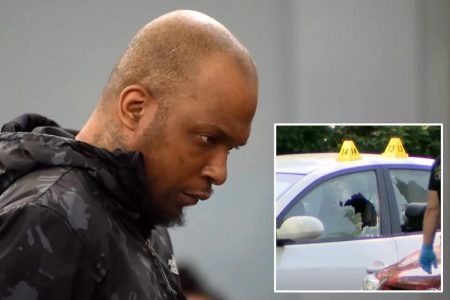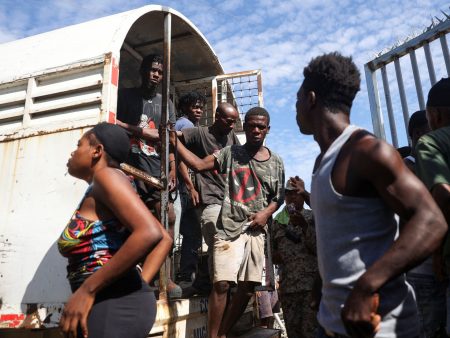Three Brooklyn teenagers, Christos Strieder, Kingson, and Navid, found themselves at the center of a real-life crime drama last December while en route to a basketball game. Just minutes after learning about the horrific murder of a homeless woman who had been set on fire on an F train, they encountered the suspected perpetrator on the very same train line. The boys, all freshmen at Millennium Brooklyn High School, had boarded the F train at 7th Avenue, their minds still processing the gruesome details of the crime and the image of the suspect, Sebastian Zapeta-Calil, which Navid’s mother had shared with them. As they settled into the train car, Christos spotted a man asleep who bore a striking resemblance to the suspect. Initially, his friends dismissed it as a joke, but a closer look confirmed their chilling realization: they were face-to-face with the alleged killer.
The suspect, Zapeta-Calil, was dressed in the same clothing described in the news reports – a black hoodie and gray sweatshirt – and was asleep, much like his victim had been. Remarkably, despite the widespread news coverage and public outcry following the heinous crime, no other passengers on the crowded train seemed to recognize the wanted man. The weight of the situation fell upon the shoulders of the three teenagers. They understood the gravity of the situation and the importance of bringing the suspect to justice. Amidst the bustling commuters and the mundane rhythm of the subway, they were acutely aware that they held a crucial piece of information, a responsibility that transcended their teenage lives.
Kingson took the initiative, discreetly dialing 911 without arousing the suspicion of Zapeta-Calil or other passengers. The three friends remained vigilant, keeping a close watch on the suspect while trying to maintain a sense of composure. As the train continued its journey, the tension mounted. Every stop, every announcement, every movement in the car heightened their awareness. Their basketball game, once the focal point of their day, faded into the background as they focused on the task at hand. They were no longer just teenagers on their way to a game; they were citizen detectives, playing a pivotal role in a real-life manhunt.
Upon reaching 34th Street-Herald Square, the train came to a halt. An announcement over the loudspeaker cited a mechanical issue, and police officers began systematically searching the train cars. In a surprising turn of events, the officers initially overlooked Zapeta-Calil during their first pass through the car. It wasn’t until the second search that they finally noticed the sleeping suspect. Once identified, officers swiftly apprehended Zapeta-Calil, escorting him off the train. At that moment, the three teenagers stepped forward, identifying themselves as the ones who had placed the crucial 911 call. The officers commended their quick thinking and civic duty.
Although the police invited the boys to the station for further questioning, the teenagers declined, prioritizing their basketball game, which they were already late for. The importance of their basketball game wasn’t merely about the sport itself, but about reclaiming a sense of normalcy after the extraordinary encounter they had just experienced. It was a way to return to the familiar rhythms of their teenage lives, to the camaraderie of their team, and the excitement of the game. They arrived just in time to contribute to their team’s victory, adding another layer of significance to an already remarkable day.
The teenagers’ bravery and swift action garnered praise from their peers, parents, and the community. Kingson even received a City Council citation for his role in apprehending the suspect. Despite the intense and potentially traumatizing experience, the boys have maintained a positive outlook and have not developed a fear of public transit. They acknowledge the inherent risks of navigating a large city but view the incident as a valuable lesson in situational awareness. Their experience underscores the importance of being observant and aware of one’s surroundings, especially in public spaces. It also highlights the power of individual action and the potential for ordinary citizens to play a crucial role in upholding public safety.
Meanwhile, Sebastian Zapeta-Calil, a 33-year-old Guatemalan migrant, has pleaded not guilty to charges of murder and arson. He claims to have been heavily intoxicated at the time of the attack and professes no memory of the incident. The prosecution alleges that he deliberately set fire to 57-year-old Debbie Kawam while she slept on the train, and even used his jacket to fan the flames. The case is ongoing, with the next court date scheduled for March. The incident serves as a stark reminder of the vulnerabilities faced by homeless individuals and the tragic consequences of violence. It also casts a light on the complexities of the justice system and the challenges of dealing with individuals who may be suffering from substance abuse or mental health issues. The three teenagers, thrust into the center of this tragic event, demonstrated remarkable courage and responsibility, their actions ultimately leading to the apprehension of a suspect and a step towards justice for the victim.










